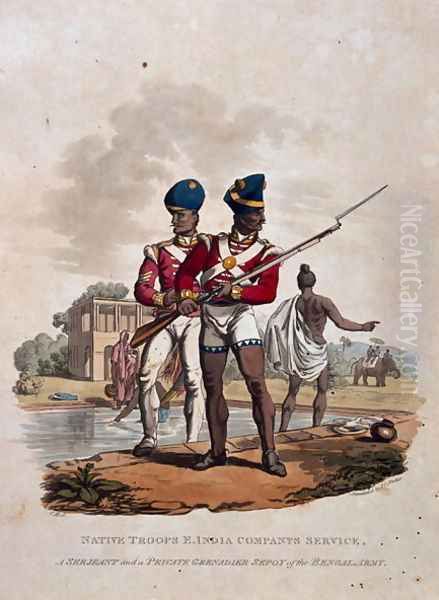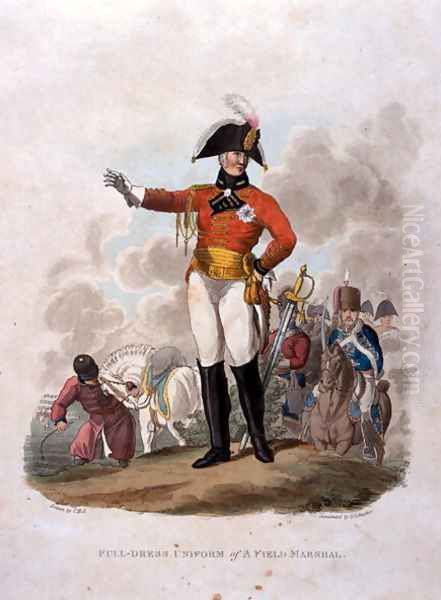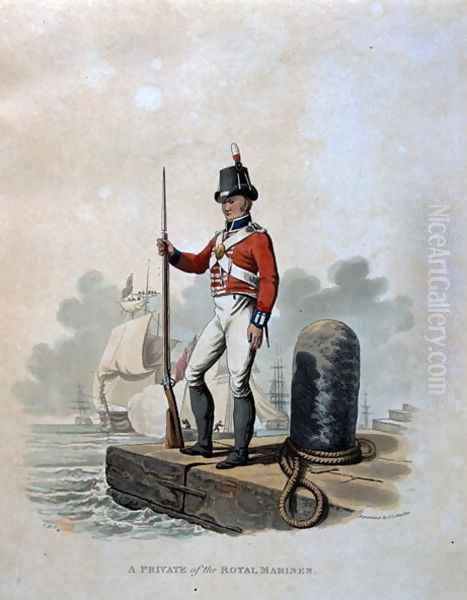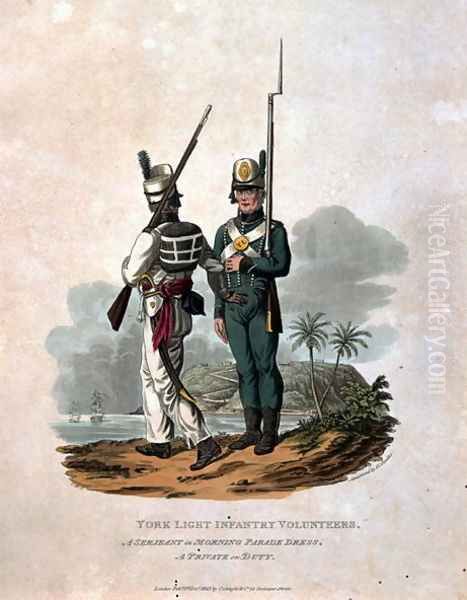Charles Hamilton Smith (1776-1859) stands as a remarkable figure of the late 18th and 19th centuries, a man whose diverse talents and insatiable curiosity led him to excel in fields that might seem disparate to a modern observer. He was a dedicated military officer, an accomplished self-taught artist, a meticulous naturalist, and a keen historical observer. His life's work, though impacted by the ravages of time and war, offers a fascinating window into the intellectual and artistic currents of his era, showcasing a profound engagement with the world around him, from the intricacies of military uniforms to the diversity of the animal kingdom.
Early Life and Formative Influences
Born Karl Godfried (or Gottfried) Smitt in Vremde, East Flanders, then part of the Austrian Netherlands (now Belgium), on December 26, 1776, Charles Hamilton Smith's early life was set against a backdrop of European political and intellectual ferment. His father was likely a Protestant Fleming, and his mother's identity remains somewhat obscure. The young Smith received his foundational military education at the Austrian academy for artillery and engineers in Mechelen and Leuven. This rigorous training would instill in him a precision and attention to detail that would later characterize his artistic and scientific endeavors.
The French Revolutionary Wars and the subsequent Napoleonic Wars dramatically reshaped the European landscape and, consequently, Smith's early career path. With the French invasion of the Low Countries, Smith, like many others, found his allegiances and opportunities shifting. He eventually made his way to Great Britain, a nation that would become his adopted home and the primary stage for his multifaceted career. His linguistic abilities, likely encompassing Flemish, German, French, and English, would have been a considerable asset in his international military and scientific pursuits.
A Distinguished Military Career

Smith's formal military career under the British crown began around 1797. He initially served in the 60th Regiment of Foot (later the King's Royal Rifle Corps), a unit known for its recruitment of foreign Protestants and its innovative light infantry tactics. His engineering skills were quickly recognized, and he saw service in the West Indies, a crucial theatre of colonial conflict. He was involved in engineering works on the island of Curaçao, which was captured by the British. His experiences in these tropical climes undoubtedly exposed him to new flora, fauna, and cultures, likely fueling his burgeoning interest in natural history and ethnography.
During the Napoleonic Wars, Smith's expertise continued to be in demand. He served as a Deputy Quartermaster-General, a role that involved significant logistical and strategic planning. One notable assignment was his involvement in the ill-fated Walcheren Expedition in 1809, a large-scale British amphibious assault in the Netherlands aimed at opening another front against Napoleon. Though the expedition itself was a strategic failure, largely due to disease and poor planning, Smith's service was recognized. He also reportedly designed plans for frontier defenses near Brussels, showcasing his strategic engineering acumen.
A fascinating anecdote from his military period, around 1800, highlights his scientific approach even within a military context. Smith conducted experiments to determine the optimal color for military uniforms, testing the visibility of different colors for riflemen. He concluded that grey was less conspicuous than green, but also that green was a more practical color for rifle corps. While the British Army did not adopt grey wholesale, his advocacy for green for light infantry and rifle units aligned with the eventual widespread use of rifle green for such specialist troops, a color famously associated with units like the 95th Rifles. His military service officially concluded in 1820 when he retired on half-pay with the rank of Lieutenant-Colonel.
The Artist and Illustrator Emerges
Parallel to his military duties, Charles Hamilton Smith cultivated a remarkable talent as a self-taught artist and illustrator. His military training, with its emphasis on precise draughtsmanship for maps and fortifications, likely provided a solid foundation. He became particularly adept with watercolors and pencil, producing works characterized by their meticulous detail and accuracy. His artistic output was prolific, spanning military subjects, natural history, and antiquarian studies.

His military background naturally led him to document the diverse uniforms of the British Army and its allies. One of his most significant contributions in this area was his work for Costume of the British Army, a series of plates published by Colnaghi & Co. and later by Ackermann. These illustrations are invaluable historical documents, providing a detailed visual record of the uniforms, accoutrements, and distinctions of various regiments during a period of significant military transformation. His work in this genre can be seen in the tradition of military artists like Denis Dighton (1792–1827), who was also known for his depictions of military life and battles of the Napoleonic era, and later figures like Richard Simkin (1850–1926) who continued this tradition of detailed uniform illustration.
Smith's precision was paramount. He didn't just capture the general appearance but also the specific details of lace, buttons, and insignia that distinguished one unit from another. These works were not merely aesthetic; they served a practical purpose for military historians, model makers, and those interested in the visual culture of the armed forces. His illustrations often depicted soldiers in dynamic poses, sometimes in small group settings, adding a sense of life to what could otherwise be static representations.
A Passion for Natural History
Beyond his military subjects, Smith harbored a deep and abiding passion for natural history, particularly zoology. He was an avid observer and collector of information, if not always of physical specimens on a vast scale. He is known to have visited numerous menageries and museums across Europe, including the Jardin des Plantes in Paris, which housed a significant collection of exotic animals, and various collections in London and Berlin. These visits allowed him to study live animals and preserved specimens firsthand, forming the basis for his detailed illustrations.
His zoological artwork is perhaps where his artistic skill and scientific curiosity most powerfully converged. He produced a vast number of watercolors of animals, ranging from mammals and birds to reptiles and fish. These illustrations were noted for their anatomical accuracy and lifelike portrayal. He contributed significantly to Sir William Jardine's (1800-1874) The Naturalist's Library (published 1833-1843), a popular and extensive series of books that aimed to make natural history accessible to a wider audience. Smith authored several volumes in this series, including those on dogs, horses, and the introduction to mammalia, and provided many of_the illustrations. His collaborators and contemporaries in this field included other notable natural history illustrators like Edward Lear (1812-1888), who, though famous for his nonsense verse, was a highly skilled ornithological artist, and James Hope Stewart who also illustrated for Jardine.

Smith's animal portraits were not mere copies; they often conveyed a sense of the animal's character and habitat. He meticulously recorded details of fur, feathers, and scales, and his understanding of animal anatomy is evident in the posture and movement he depicted. Some of his notable individual animal studies include detailed renderings of rhinoceroses, such as the Rhinoceros of the Island of Sunda (Sumatran Rhinoceros) and the Rhinoceros of Africa. He also depicted lesser-known species like The Greater Grison, a South American mustelid. His work can be compared to the meticulousness of artists like the Austrian brothers Franz Bauer (1758–1840) and Ferdinand Bauer (1760–1826), renowned for their botanical and zoological illustrations, or the French master of flower painting, Pierre-Joseph Redouté (1759–1840), whose precision set a high standard for scientific illustration.
His approach was that of a true naturalist-artist, in the vein of earlier figures like Maria Sibylla Merian (1647-1717), who combined scientific inquiry with artistic skill in her studies of insects and plants, or later, the great American ornithologist-artist John James Audubon (1785-1851), whose Birds of America set a new benchmark for wildlife art. While Smith may not have achieved the same level of international fame as Audubon, his contributions were significant, particularly in popularizing natural history in Britain.
Ethnography and Antiquarian Pursuits
Smith's interests extended to the study of humankind. In 1848, he published The Natural History of the Human Species, a work that reflected the anthropological theories of its time. This book attempted to classify the races of mankind, a common pursuit in 19th-century science, but one whose methodologies and conclusions are now largely outdated and considered unscientific and often racist by modern standards. It's important to view this work within its historical context, where figures like Johann Friedrich Blumenbach (1752–1840) were developing early racial classification systems. Smith's book, illustrated with plates, discussed various human groups, their physical characteristics, and supposed temperaments. While its scientific value is now minimal, it stands as a document of 19th-century attempts to understand human diversity, however flawed.
He also produced works related to historical costume beyond the purely military. One title sometimes associated with him or his style is Costume of the Original Inhabitants of the British Islands (with Samuel Rush Meyrick) and he was interested in ancient and medieval arms and armor. This interest in historical attire and artifacts connected with his broader antiquarian pursuits, a popular field of study in the 19th century, which saw gentlemen scholars meticulously documenting the past. His eye for detail, honed in military and natural observation, served him well in these endeavors.
Artistic Style and Influences

Charles Hamilton Smith's artistic style was predominantly realistic and descriptive. His primary aim, whether depicting a soldier's uniform or an animal's pelt, was accuracy and clarity. He employed fine lines and careful application of watercolor washes to build up form and texture. His compositions were generally straightforward, focusing on the subject with minimal, if any, elaborate backgrounds, especially in his scientific illustrations. This approach ensured that the viewer's attention was drawn to the essential details of the subject.
While his work was largely functional, serving to document and inform, it was not without aesthetic merit. His animal portraits, in particular, often possess a quiet dignity. In terms of broader artistic influences, while he was self-taught, he would have been aware of the prevailing artistic trends. The Romantic movement, with its emphasis on nature and the sublime, was in full swing during his lifetime. Artists like J.M.W. Turner (1775-1851) and John Constable (1776-1837) were revolutionizing landscape painting in Britain. While Smith's style was very different, the general cultural appreciation for nature likely provided a supportive environment for his natural history work.
For landscape elements that occasionally appeared in his more composed pieces, or in his general visual literacy, he might have looked to classical landscape painters like Nicolas Poussin (1594–1665) and Claude Lorrain (1600–1682), whose structured compositions were still influential, or the more dramatic landscapes of Salvator Rosa (1615–1673). However, his primary focus remained the accurate depiction of specific subjects rather than evocative landscape painting. His dedication to empirical observation aligned him more closely with the scientific illustrators of his day than with the mainstream fine art movements, though the line between scientific illustration and art was often more blurred than it is today. The work of George Stubbs (1724-1806), renowned for his anatomically precise paintings of horses, predates Smith but set a high standard for animal portraiture that combined art and scientific understanding, a tradition Smith continued.
Later Life in Plymouth and Legacy
After retiring from active military service in 1820, Charles Hamilton Smith eventually settled in Plymouth, Devon. He remained intellectually active, becoming involved with local learned societies. He was a prominent member and one-time President of the Plymouth Institution (now The Plymouth Athenaeum), a society dedicated to the promotion of science, literature, and art. He frequently lectured there, sharing his extensive knowledge on a variety of subjects.
His vast collection of notes and drawings, estimated at over 20,000 items, was a testament to his industry and wide-ranging interests. These manuscripts and illustrations covered military history, natural history, archaeology, and ethnology. A significant portion of his work was eventually donated or bequeathed to institutions. The Plymouth Institution was a major beneficiary, though tragically, much of this collection was destroyed or severely damaged during the Plymouth Blitz in World War II in 1941 when the Athenaeum building was hit by bombs. This loss was a significant blow to the preservation of his oeuvre. Some of his works also found their way to other collections, including the American Museum of Natural History.
Despite the loss of much of his physical work, Smith's influence persisted. His published illustrations, particularly in The Naturalist's Library and his military costume series, continued to be referenced. He was a corresponding member of various learned societies, indicating his recognized status within the scientific and historical communities of his time. He was elected a Fellow of the Royal Society in 1824 and a Fellow of the Linnean Society in 1826, prestigious honors that acknowledged his contributions to science.
Charles Hamilton Smith passed away in Plymouth on September 21, 1859, at the age of 82. He left behind a legacy as a polymath – a soldier, scientist, and artist whose work bridged different disciplines. He was a product of an age where the lines between amateur and professional, and between art and science, were more fluid. His dedication to meticulous observation and accurate representation provided valuable resources for his contemporaries and for future generations, even if some of his theoretical work, particularly in ethnography, has not stood the test of time.
Conclusion: A Man of Many Parts
Charles Hamilton Smith's life and career exemplify the spirit of inquiry and multifaceted talent that characterized many notable figures of the 19th century. From the battlefields of the Napoleonic Wars to the quiet study of natural specimens, he applied a keen intellect and a skilled hand. His military illustrations preserve a vital record of a transformative period in British military history. His natural history artwork contributed to the dissemination of zoological knowledge and captured the beauty and diversity of the animal kingdom with precision and care.
Though perhaps not a household name in the annals of art history in the same way as some of his purely "fine art" contemporaries, Smith's contribution lies in his role as a meticulous documenter, an illustrator who served both science and history. His work reminds us of the crucial role that visual representation plays in understanding the world, whether it be the distinctions of a regimental uniform or the subtle variations in an animal species. He was a diligent scholar and a gifted artist whose legacy, though partly obscured by the misfortunes of war, continues to offer valuable insights into the military, natural, and human history of his time. His life was a testament to the power of observation and the enduring human desire to understand and record the complexities of the world.